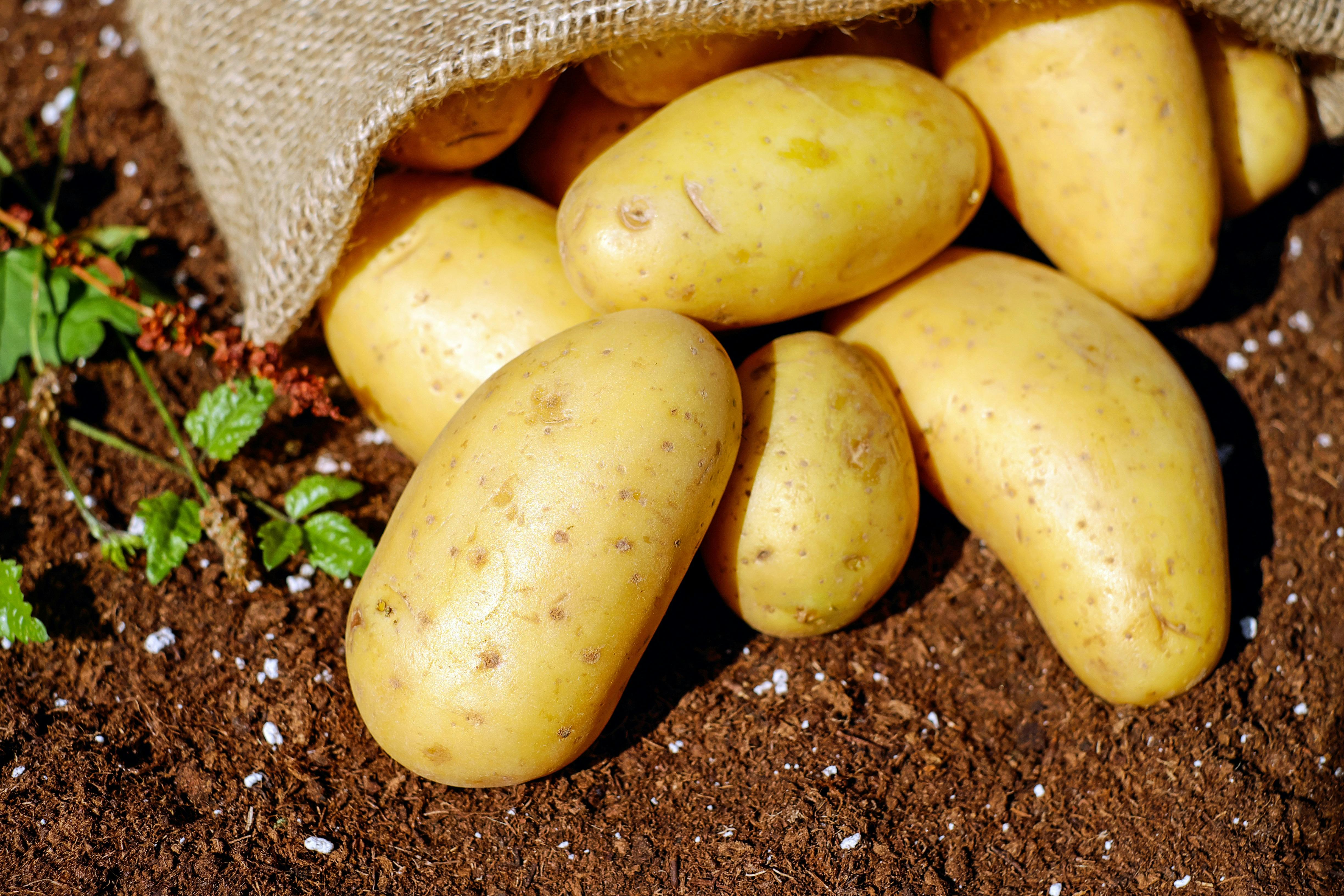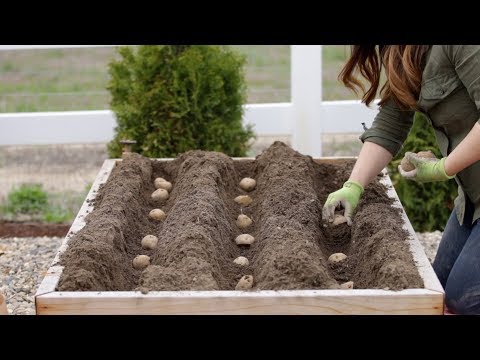Potatoes are an easy-to-grow, versatile vegetable that can be a part of any garden. Knowing how deep to plant potatoes will help you get the most out of your harvest. Planting potatoes too shallowly can cause them to become exposed and rot, while planting them too deep can lead to stunted growth. To get the best results from your potato crop, it’s important to understand the basics of how deep to plant potatoes. In this article, we’ll discuss the ideal depth for planting potatoes and provide helpful tips for doing it correctly.The best time to plant potatoes is in early to mid spring, when the soil temperature has reached 50°F or higher. Planting potatoes too early may result in reduced yields due to frost damage or rot. Make sure you choose an area that receives full sun and has loose, well-draining soil for optimal growth.
Soil Preparation for Planting Potatoes
Preparing the soil for planting potatoes is an important step in growing a successful crop. Proper soil preparation will ensure that your potatoes have the best chance of growing healthy and producing a good yield. The process begins by selecting the best location for your potato patch. Choose a site with full sun, good drainage, and plenty of air circulation. Once you have selected the site, it’s time to prepare the soil.
The soil should be tilled to a depth of 8-10 inches and any large clumps should be broken up. The area should then be fertilized according to the recommendation on fertilizer package labels or with compost or manure. If you are using manures, make sure they are fully composted before applying them to avoid burning the plants. Once fertilization is complete, it is time to plant your potatoes.
Potatoes can be planted directly into hills or rows in the ground, or in raised beds or containers if you prefer. In either case, make sure that the soil is firm and free of weeds before planting your potatoes. Planting holes should be dug 6-8 inches deep and 2-3 feet apart in rows that are 3 feet apart. Place one seed potato in each hole with the cut side facing down and cover with 2-3 inches of soil, tamping down lightly after covering each seed potato.
Once all of your seed potatoes have been planted, water them thoroughly and mulch around each hill with straw or other organic material to help retain moisture and discourage weeds from taking over your potato patch. With proper preparation and attention throughout the growing season, you will soon be rewarded with a bountiful harvest of delicious potatoes!
How Deep Should Potatoes Be Planted?
Potatoes should be planted about 8 to 10 inches deep in the soil. This depth helps protect the potato tubers from freezing temperatures and allows them to develop strong root systems. It also ensures that the potatoes will have enough soil around them to hold in moisture and nutrients. When planting, make sure to leave enough room between each potato so that they can spread out and develop a good root system. The soil should be loose and well-drained, with plenty of organic matter added for good drainage and fertility. After planting, cover the potatoes with a few inches of soil and water them thoroughly. As the plants grow, add more soil to keep the tubers covered, but make sure not to bury them too deep or they may rot.
Soil Requirements for Planting Potatoes
Potatoes grow best in evenly moist, well-drained soil that is high in organic matter. The pH should be between 4.8 and 5.5 or slightly acidic. To prepare the soil for planting, incorporate aged compost, peat moss, or manure to help retain moisture and nutrients. Rototill the soil to a depth of 8-10 inches and remove any stones or large clumps. Rake the soil smooth and break up any lumps before planting potatoes.
Climate Requirements for Planting Potatoes
Potatoes prefer cool weather with plenty of sunshine during the growing season. Plant potatoes when temperatures are between 45°F and 85°F (7-29°C). Potato plants can survive light frosts but may be damaged by hard freezes. In areas with short growing seasons, start seed potatoes indoors about 10 to 12 weeks before the last frost date.
Planting Requirements for Potatoes
Plant potatoes in rows about 3 feet apart with seeds spaced about 12 inches apart in the row. Plant seeds 1-2 inches deep and cover with soil. As plants grow, mound extra soil around them to keep developing tubers covered until harvest time. When planting multiple rows of potatoes, space rows at least 30 inches apart.
After planting, water thoroughly so that water penetrates at least 6 inches into the soil and use a mulch such as straw or leaves around potato plants to retain moisture until harvest time. Provide adequate water throughout the growing season; potatoes need 1 inch of water per week to grow properly.
Deep Planting of Potatoes
Deep planting of potatoes is a technique used to increase the yield and quality of potatoes. It involves planting the potato seedlings deeper than normal in the soil, typically between 10 and 18 inches deep. The deeper root system of the plant allows it to access more nutrients and moisture from the soil, resulting in higher yields and bigger potatoes. Deep planting also helps protect the tuber from damage caused by wind, hail, or frost. Additionally, it can improve the flavor and texture of potatoes, making them more appealing to consumers.
Advantages
The main advantage of deep planting is increased yield. By planting deeper into the soil, potatoes are able to access more nutrients and water which leads to larger plants with more tubers per plant. This can result in a significantly higher yield than traditional shallow planting techniques. Additionally, deep planting can help protect potato tubers from physical damage caused by wind and hail which can reduce yields significantly.
Another advantage of deep planting is improved flavor and texture of potatoes. By accessing more nutrients from deeper in the soil, potatoes are able to grow larger with firmer flesh and a richer flavor than shallow planted potatoes. This makes them more appealing to consumers who will be willing to pay higher prices for superior quality produce.
Finally, deep planting can help reduce disease pressure on potato crops as there is less contact between tubers and soil-borne pathogens at greater depths. Soil temperatures are also cooler at greater depths which can slow down disease development compared to shallow planted crops.
Disadvantages
One potential disadvantage of deep planting is increased labor costs as it requires specialized equipment that may not be available for small scale operations or those farming on a budget. Additionally, deep planted crops may require additional fertilizer inputs due to increased nutrient uptake from deeper in the soil which can add to production costs as well as environmental concerns if not managed properly. Finally, harvesting deep planted crops may also be challenging depending on soil type and crop management practices as tubers may need to be dug out manually or with machinery such as a spade or tiller which adds additional labor costs as well as time constraints if done manually during peak harvest season when time is limited for other tasks such as weeding or field preparation for future crops.

Spacing and Depth for Planting of Potatoes
Planting potatoes requires correct spacing and depth to ensure healthy growth and maximize yield. Potato plants need adequate space to grow, spread their roots, and absorb nutrients. The optimum spacing between potato plants is usually 12-18 inches, depending on the variety. For a row garden, the distance between rows should be at least 30 inches. If planting in hills, the distances should be increased to 18-24 inches. Potato seeds are planted 2-4 inches deep in well-drained soil that is free of weeds and debris. It is important to avoid over-crowding potato plants as this can lead to disease and pest problems. Additionally, the depth of planting should be adjusted accordingly if planting in raised beds or containers.
When it comes to harvesting potatoes, spacing also plays an important role. If potatoes are spaced too close together when planted, they will produce smaller tubers than if they are spaced further apart. Therefore, it is best to give potato plants ample room when planting in order to maximize yields at harvest time. Additionally, potatoes that are planted too deep can become deformed as they struggle for light and air when growing underground. Therefore, it is important to plant potatoes at the correct depth in order for them to reach their full potential without any deformities.
In conclusion, proper spacing and depth are essential for successful potato growth and maximum yield at harvest time. To ensure healthy growth of potato plants throughout the season, make sure that each plant has adequate space between neighbors as well as sufficient depth when planting the seeds or tubers.
Sunlight Requirements for Growing Potatoes
Potatoes are a popular crop that can be grown in a wide variety of climates. To ensure successful crop production, potatoes require an adequate amount of sunlight and should be planted in an area that receives at least six hours of direct sunlight every day. The best time to plant potatoes is during the early spring when the weather is cool and the soil has warmed up enough for proper germination.
When planted in full sun, potatoes will produce larger tubers with more nutrients and flavor. The size of the potato crop will also be larger when grown in full sun compared to shady areas. If growing potatoes in partial shade is unavoidable, then it is important to choose a variety that is better suited for such conditions.
It is also important to note that too much sun can damage the potato plants. Too much direct sunlight can cause the foliage to scorch and become discolored, while excessive heat can cause the tuber’s skin to become tough and bitter-tasting. Therefore, it is important to make sure that there is sufficient shade available during hot summer days and that the soil does not dry out too quickly due to high temperatures or strong winds.
To ensure optimal growth, it is essential to provide enough water on a regular basis, typically once or twice per week depending on weather conditions. Mulching around potato plants can help conserve moisture levels in the soil and keep weeds at bay. It is also important to rotate potato crops each year as this prevents diseases from building up in the soil which can reduce yields over time.
In conclusion, potatoes require adequate amounts of sunlight each day for successful growth and yields. When planting potatoes, it is important to choose an area with at least six hours of direct sunlight every day and take steps such as mulching and irrigation if needed to protect against drought or extreme heat conditions.
Water Requirements for Growing Healthy Potatoes
Potatoes are a popular crop to grow in the home garden and they require adequate water to produce a healthy harvest. When it comes to watering potatoes, the key is to make sure they get enough but not too much. Too little water can cause stunted growth and poor yields, while too much can lead to disease problems and rot. To ensure optimal growth, potatoes need about an inch of water per week, either from rainfall or supplemental irrigation. The best way to measure this is with a rain gauge or soil moisture meter.
It’s important to note that potatoes require different amounts of water at different stages of growth. During the early stages of growth, when the plants are establishing their roots, they need less water than when they are flowering and setting fruit. During this time it is important to keep the soil consistently moist, but not soaked. The amount of water needed will depend on soil type and weather conditions, so be sure to adjust your irrigation accordingly.
At the end of the growing season, when potatoes are ready for harvest, it’s important to reduce watering gradually over several weeks so as not to shock or damage the plants. This will also help prevent disease problems as well as allow for better storage of harvested potatoes.
Overall, when it comes to watering potatoes, it’s all about finding that sweet spot between too much and too little. With proper care and attention you can ensure a healthy potato crop with optimal yields every time.

Conclusion
Planting potatoes at the correct depth is essential for healthy and abundant harvests. Potato tubers should be planted 4 inches deep in light, well-draining soils, and 6–8 inches deep in heavier soils. Planting potatoes too shallow can lead to sun scalding, pest damage, or tuber rot. Conversely, planting potatoes too deep can lead to lower yields due to reduced sprouting and less nutrient absorption.
To ensure successful planting and harvests, gardeners should properly prepare the soil before planting by removing stones and weeds from the bed, incorporating organic matter into the soil, and working in a complete fertilizer. Additionally, gardeners should keep their potatoes mulched with straw or grass clippings to conserve water and prevent weed growth. With these tips in mind, gardeners can produce a healthy crop of delicious potatoes.
In conclusion, planting potatoes correctly is essential for a successful harvest. Gardeners should plant potatoes 4–8 inches deep depending on soil type and texture while keeping them mulched with straw or grass clippings during their growth cycle. Following these steps will help ensure that gardeners have an abundant crop of delicious potatoes come harvest time.

